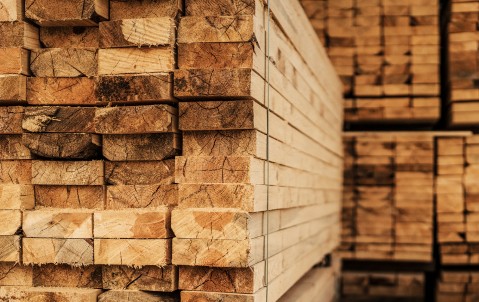
US homeowners lumbered with higher rebuild costs could face underinsurance
As lumber costs spiral in North America, the insurance industry will need to work together to prevent homeowners suffering underinsurance problems.
In 2020, a US developer could take US$50,000 worth of lumber and construct ten homes. Just over a year later and, for that same US$50,000 – according to figures from the visualcapitalist.com – the developer would only get enough lumber to complete two homes. The dramatic rise in the cost of lumber for construction is further illustrated in statistics revealing a 100% increase in price over the 12 months to May 2021, compared to just over 21% for a basket of related construction materials.
While these inflationary pressures create issues for new builds, they are also causing problems for homeowners and potential underinsurance issues. “Given the importance of lumber in rebuild costs,” says Alex Kickham, Household Line Underwriter for Hiscox London Market, “US homeowners could find themselves inadequately covered when it comes to making a claim. Given it’s not in the insurance industry’s interests either to allow underinsurance, the market needs to be both more agile and sophisticated in its response to lumber cost in terms of pricing and agreeing insured values, while also improving communication with its insureds.”
Supply crunch, demand surge
Lumber isn’t the only commodity to be experiencing inflation in the US and North America. The Wall Street Journal reports 12 month increases in crude oil prices (99%), copper (89%), soya beans (83%), sugar (56%), and cotton (40%), with lumber as the real standout at 275%. But why has lumber become the outlier? Covid-19 has slowed down lumber production and hit supply, but that’s not the only factor at play, says Kickham. “Wildfires have hit production areas in the US and Canada on the supply side, as well as a beetle infection in British Columbia, but the increase in renovations and homebuilding in the US is also creating a demand surge.” Reuters reports that construction of new homes reached a fifteen year high in March, partly driven by a rise in people looking to move out of cities with changing working patterns fuelling a demand for bigger and more expensive homes.
The Wall Street Journal reports 12 month increases in crude oil prices (99%), copper (89%), soya beans (83%), sugar (56%), and cotton (40%), with lumber as the real standout at 275%.
Price inflation vs claims inflation and the heightened hurricane risk
Consequently, a key issue facing most insurers is the lag effect of price inflation compared to claims inflation. The latter is felt immediately when the cost of raw materials increases but insured values don’t see a corresponding increase until the annual renewal of a policy. This effect is likely to be exacerbated in the upcoming hurricane season where estimates suggest the costs of a major hurricane could be raised by 10%-20% due to the recent lumber cost spike. This is in addition to the normal demand surge that we see associated with major hurricane events – for context, lumber prices went up by circa 50% in a one-year period after Hurricanes Harvey, Irma and Maria in 2017.
Inadequately covered homeowners
The problem for most insurers and insureds in responding to this issue, is a lack of sophistication in the valuation cycle and the agility needed to reflect the changing lumber costs over a relatively short time. “If you have a homeowner renewing their policy every year but only having their values appraised every three years for example, the values covered will quickly become inadequate given the rate that lumber has increased in just 12 months. That means the homeowner risks not being adequately covered in the event they make a claim for a rebuild,” says Hiscox’s George Frith – Household Underwriter. “Under a coinsurance clause, for example, a homeowner could end up with a reduced pay-out and having to make up the difference in the rebuild cost.”
The problem for most insurers and insureds in responding to this issue, is a lack of sophistication in the valuation cycle and the agility needed to reflect the changing lumber costs over a relatively short time.
“Underinsurance is also more likely to be an issue for regular value homes,” Frith adds, “rather than the higher value homes subject to regular and thorough inspections. This raises the challenge of how insurers can get better at responding to these fast-moving variable costs to make sure both the appropriate premiums are charged and insureds are secure that they have the right insurable values on their policy.”
Use of valuation estimator tools to factor in price increases for materials like lumber can help, especially on regular value homes where replacement values are more standardised but again, “the valuation exercise will need to be done annually if it’s to have any value,” says Frith. Moreover, for higher value homes, these tools don’t necessarily reflect the custom nature of the build such as the cabinetry commissioned for a built-in wardrobe, so again insureds might find themselves in a position of inadequate cover.
Raise awareness
Responding quicker to the changing risk profile from an underwriting perspective will be increasingly important which is why Hiscox works with their insured customer base to ensure adequate valuations through several different mechanisms ranging from annual inflationary endorsements to policies, to comprehensive inspection and valuation appraisals with partner companies at regular intervals – in some jurisdictions this cost is borne entirely by Hiscox themselves. But the market will also need to raise general awareness of insuring to value and making sure that homeowners are insured for the true replacement cost of their homes. “That means insurers and retail agents/brokers working closely together so that insureds understand why premiums are increasing to meet the real replacement costs of damage to their homes,” says Kickham.
Looking ahead, the US and North America are likely to experience more inflationary pressures as lockdowns recede and economic activity picks up. According to the latest figures from the US Bureau of Labor Statistics, consumer prices were up 4.2% in the 12 months to April 2021, representing the biggest increase since September 2008. “Which means that higher lumber prices are likely to be around for some time and could be joined by other factors such as labour costs and supply chain issues further pushing up claims costs,” warns Kickham. “And further raising the need for the insurance market to respond with agility and better communication to make sure homeowners get the right levels of cover they need.”



